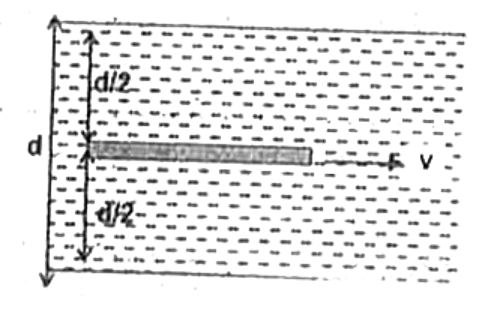A metal plate 0.04m2 in area is lying on a liquid layer of thickness 10−3m and coefficient of viscosity 140 poise. Calculate the horizontal force needed to move the plate with a speed of 0.040 m/s.
The correct Answer is:A
To solve the problem of calculating the horizontal force needed to move a metal plate on a liquid layer, we will use the formula derived from Newton's law of viscosity. Here is the step-by-step solution:
Step 1: Identify the given values
- Area of the plate, A=0.04m2
- Thickness of the liquid layer, Δx=10−3m
- Coefficient of viscosity, η=140poise
- Speed of the plate, v=0.040m/s
Step 2: Convert the coefficient of viscosity to SI units
The coefficient of viscosity in SI units is given by:
1poise=0.1Pa.s
Thus,
η=140poise=140×0.1Pa.s=14Pa.s
Step 3: Calculate the velocity gradient
The velocity gradient dvdx is defined as the change in velocity per unit distance. Since the plate moves with a constant speed, we can express this as:
dvdx=vΔx
Substituting the values:
dvdx=0.040m/s10−3m=40s−1
Step 4: Apply the formula for force
According to Newton's law of viscosity, the force F required to move the plate is given by:
F=η⋅A⋅dvdx
Substituting the known values:
F=14Pa.s⋅0.04m2⋅40s−1
Step 5: Calculate the force
Now we can compute the force:
F=14⋅0.04⋅40
F=14⋅1.6
F=22.4N
Final Answer
The horizontal force needed to move the plate is F=22.4N.
---
- Area of the plate, A=0.04m2
- Thickness of the liquid layer, Δx=10−3m
- Coefficient of viscosity, η=140poise
- Speed of the plate, v=0.040m/s
The coefficient of viscosity in SI units is given by:
1poise=0.1Pa.s
Thus,
η=140poise=140×0.1Pa.s=14Pa.s
The velocity gradient dvdx is defined as the change in velocity per unit distance. Since the plate moves with a constant speed, we can express this as:
dvdx=vΔx
Substituting the values:
dvdx=0.040m/s10−3m=40s−1
According to Newton's law of viscosity, the force F required to move the plate is given by:
F=η⋅A⋅dvdx
Substituting the known values:
F=14Pa.s⋅0.04m2⋅40s−1
Now we can compute the force:
F=14⋅0.04⋅40
F=14⋅1.6
F=22.4N
The horizontal force needed to move the plate is F=22.4N.
Topper's Solved these Questions
- CURRENT ELECTRICITYBOOK - RESONANCE ENGLISHCHAPTER - CURRENT ELECTRICITYEXERCISE - Exrcies-3(PART-1)
22 Videos
- CURRENT ELECTRICITYBOOK - RESONANCE ENGLISHCHAPTER - CURRENT ELECTRICITYEXERCISE - Exrcies-3(PART-2)
23 Videos
- CURRENT ELECTRICITYBOOK - RESONANCE ENGLISHCHAPTER - CURRENT ELECTRICITYEXERCISE - Exercise-2 (Part-3)
22 Videos
- COMMUNICATION SYSTEMSBOOK - RESONANCE ENGLISHCHAPTER - COMMUNICATION SYSTEMSEXERCISE - Exercise 3
13 Videos
- DAILY PRACTICE PROBLEMBOOK - RESONANCE ENGLISHCHAPTER - DAILY PRACTICE PROBLEMEXERCISE - DPP.No.71
1 Videos
Similar Questions
A metal plate 5cm×5 cm rests on a layer of castor oil 1 mm thick whose coefficient of viscosity is 1.55Nsm−2 . Find the horizontal foce required to move the plate with a speed of 2 cm/s
View SolutionA plate of area 100cm2 is placed on the upper surface of castor oil, 2mm thick. Taking the coefficient of viscosity to be 15.5 poise, calculate the horizontal force necessary to move the plate with a velocity 3cms−1.
View SolutionBetween a plate of area 100cm2 and another plate of area 100m2 there is a 1mm, thick layer of water, if the coefficient of viscosity of water is 0.01 poise, then the force required to move the smaller plate with a velocity 10cms−1 with reference to large plate is
View Solutionflat plate is separated from a large plate by a layer of glycerine of thickness 3×10−3m. If the coefficient of viscosity of glycerine is2Ns/m2 what is the force required to keep the plate moving with a velocity of6×10−2m/s. Area of the plate is 4.8×10−3m
View SolutionA metal square plate of 10cm side rests on 2mm thick caster oil layer. Calculate the horizontal force needed to move the plate with speed 3cms−1:( Coefficient of viscosity of caster oil is 15 poise. )
View SolutionThere is a 1mm thick layer of glycerine between a flat plate of area 100cm2 and and a big plate. If te coefficient of viscosity of glycerine is 1.0kg/m−sec, then how much force is required to move the plate with a velocity of 7 cm/sec.
View SolutionA thin square plate of side φ=10cm is dragged with constant velocity v=3 cm/s in an oil . The width 'd' of the oil column is 2mm. Square plate is placed symmetrically as shown in the figure. Assumed velocity of layer of oil at the end is negligible. The coefficient of viscosity is 150 poise. Find the horizontal force (in Newton) required to move the square plate with constant velocity

View SolutionAflat plate of area 0.05m2 is separated from another large plate at rost by a liquid layer of uniform thickness 1μm. The tangential force needed to move the smaller plate with a constant velocity of 10cms−1 i s 20 N. Calculate the coefficent of viscosity of the liquid.
View SolutionA plate of area 2m2 is made to move horizontally with a speed of 2m/s by applying a horizontal tangential force over the free surface of a liquid. If the depth of the liquid is 1m and the liquid in contact with the bed is stationary. Coefficient of viscosity of liquid is 0.01 poise. Find the tangential force needed to move the plate.
View SolutionA plate of area 2m2 is made to move horizontally with a speed of 2m/s by applying a horizontal tangential force over the free surface of a liquid. If the depth of the liquid is 1m and the liquid in contact with the bed is stationary. Coefficient of viscosity of liquid is 0.01 poise. Find the tangential force needed to move the plate.
View Solution
